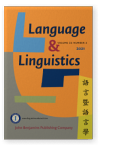Vol. 22:2 (2021) ► pp.302–337
Marking definiteness in an articleless language
The role of the domain restrictor KU in Korean
The main purpose of this paper is to identify the novel type of Korean definiteness marker. Especially I show that Korean KU which originated from the morphological demonstrative ‘that’, instantiates a solid pattern of distribution of definiteness marker. Mainly focusing on the semantico-pragmatic role of KU, the proposal comprises three main parts: (i) Given that Korean employs distinct devices teased apart into uniqueness (i.e. referential use) and familiarity (i.e. anaphoric use) in its definiteness system, I show that the effect of referential use in argument saturating function is achieved by the covert “determiner” in bare nouns, whereas anaphoric use in argument non-saturating function is achieved by the overt KU; (ii) The semantic contribution of KU is analyzed as a domain restrictor (DDR; Etxeberria & Giannakidou 2010) which supplies an indexical property as an argument (Schwarz 2009, 2013; Jenks 2018); (iii) I further show that the DDR operator is present in the syntax, falling out from the standard D position as an adjunctive modifier in a lower DP layer. The contribution of my work is that the proposed account allows us to widen our view of cross-linguistic variation to cases where the prerequisite of definiteness is based on the dissociation of meaning (i.e. the semantic role of D as encoding familiarity) and form (i.e. the syntactic role of D as an argument-building function).
Article outline
- 1.Introduction
- 2.Theoretical background on definiteness
- 3.Data: Core properties of definite KU
- 3.1Familiarity
- 3.2(Anti-)uniqueness/maximality
- 3.3Domain restriction
- 4.Analysis: KU as a contextual domain restrictor
- 5.Conclusions
- Acknowledgements
- Notes
- Abbreviations
-
References
For any use beyond this license, please contact the publisher at [email protected].
